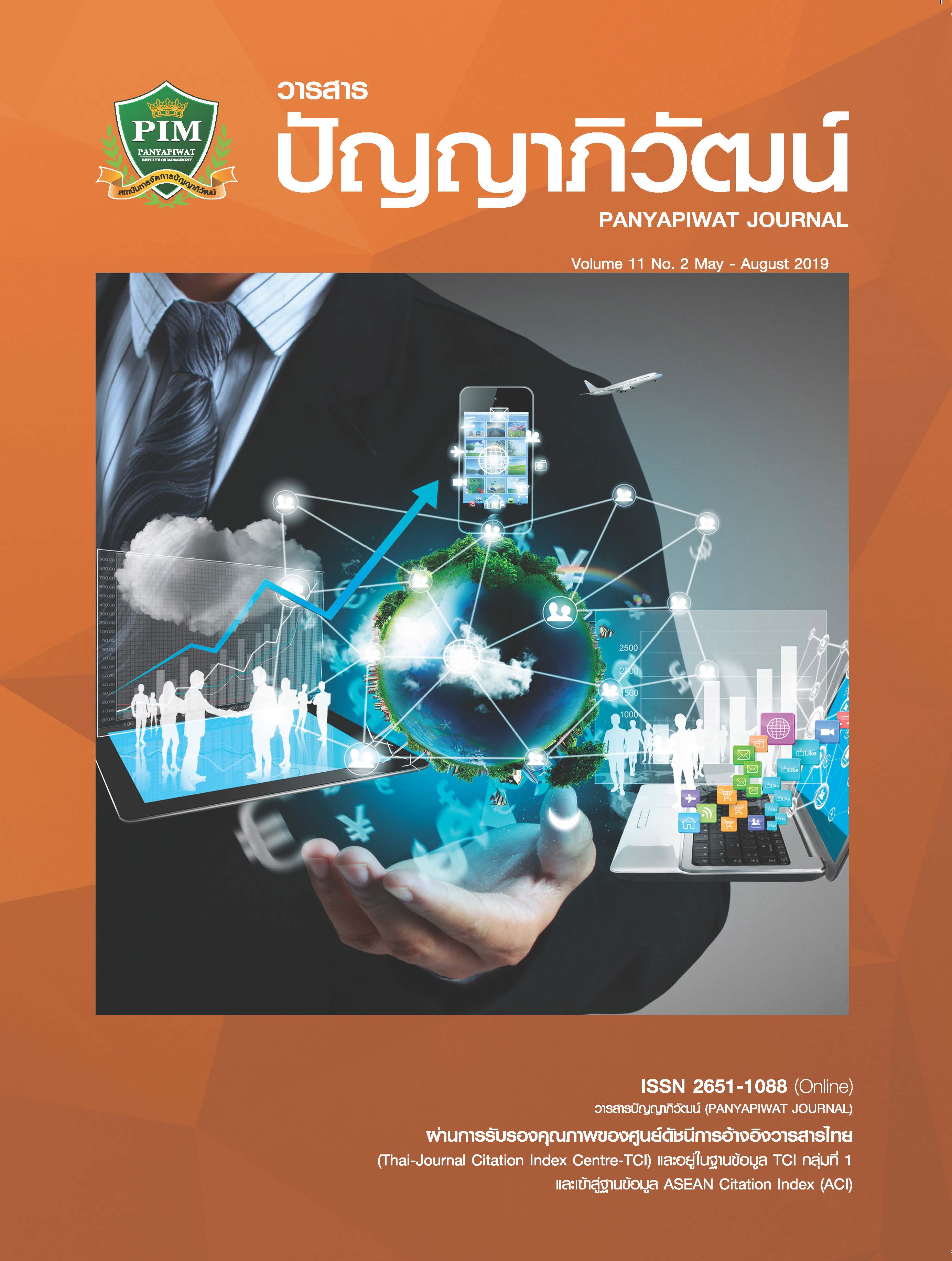การวิเคราะห์องค์ประกอบเชิงยืนยันของปัจจัยที่มีผลต่อความตั้งใจใช้กระเป๋าเงินดิจิทัล
Main Article Content
บทคัดย่อ
การวิจัยครั้งนี้มีวัตถุประสงค์เพื่อ 1) วิเคราะห์องค์ประกอบเชิงยืนยันของปัจจัยที่มีอิทธิพลต่อความตั้งใจใช้กระเป๋าเงินดิจิทัล และ 2) ตรวจสอบความกลมกลืนขององค์ประกอบเชิงยืนยันของปัจจัยที่มีอิทธิพลต่อความตั้งใจใช้กระเป๋าเงินดิจิทัลตามสมมติฐานกับข้อมูลเชิงประจักษ์ โดยใช้แบบสอบถามกลุ่มตัวอย่างประชาชนในพื้นที่กรุงเทพมหานคร จำนวน 300 คน โดยใช้เทคนิคการวิเคราะห์แบบจำลองสมการโครงสร้างในการวิเคราะห์ข้อมูล
ผลการวิจัยพบว่า ตัวแบบองค์ประกอบเชิงยืนยันของปัจจัยที่มีผลต่อความตั้งใจใช้กระเป๋าเงินดิจิทัลมีความสอดคล้องกับข้อมูลเชิงประจักษ์ โดยความตั้งใจในการใช้ได้รับอิทธิพลทางตรงเชิงบวกจากทัศนคติต่อการใช้งานมากที่สุด รองลงมาคือ การรับรู้ว่ามีประโยชน์ ส่วนทัศนคติต่อการใช้งานได้รับอิทธิพลทางตรงเชิงบวกจากการรับรู้ว่ามีประโยชน์มากที่สุดรองลงมาคือ การรับรู้ว่าง่ายในการใช้งาน นอกจากนี้ทัศนคติต่อการใช้งานยังเป็นตัวแปรคั่นกลางเพียงหนึ่งเดียวที่ส่งอิทธิพลต่อความตั้งใจใช้กระเป๋าเงินดิจิทัล
Article Details
“ข้าพเจ้าและผู้เขียนร่วม (ถ้ามี) ขอรับรองว่า บทความที่เสนอมานี้ยังไม่เคยได้รับการตีพิมพ์และไม่ได้อยู่ระหว่างกระบวนการพิจารณาลงตีพิมพ์ในวารสารหรือแหล่งเผยแพร่อื่นใด ข้าพเจ้าและผู้เขียนร่วมยอมรับหลักเกณฑ์การพิจารณาต้นฉบับ ทั้งยินยอมให้กองบรรณาธิการมีสิทธิ์พิจารณาและตรวจแก้ต้นฉบับได้ตามที่เห็นสมควร พร้อมนี้ขอมอบลิขสิทธิ์บทความที่ได้รับการตีพิมพ์ให้แก่สถาบันการจัดการปัญญาภิวัฒน์หากมีการฟ้องร้องเรื่องการละเมิดลิขสิทธิ์เกี่ยวกับภาพ กราฟ ข้อความส่วนใดส่วนหนึ่งและ/หรือข้อคิดเห็นที่ปรากฏในบทความข้าพเจ้าและผู้เขียนร่วมยินยอมรับผิดชอบแต่เพียงฝ่ายเดียว”
เอกสารอ้างอิง
Alalwan, A. A., Dwivedi, Y. K., Rana, N. P. & Williams, M. D. (2016). Consumer adoption of mobile banking in Jordan Examining the role of usefulness, ease of use, perceived risk and self-effcacy. Journal of Enterprise Information Management, 29(1), 118-139.
Al-Sharaf, M. A., Arshah, R. A., Herzallah, F. A. T. & Alajmi, Q. (2017). The Effect of Perceived Ease of Use and Usefulness on Customers Intention to Use Online Banking Services: The Mediating Role of Perceived Trust. International Journal of Innovative Computing, 7(1), 9-14.
Agarwal, S. (2016). Initial euphoria of prepaid wallets dies down. Retrieved March 15, 2018, from https://economictimes.indiatimes.com/industry/banking/fnance/initial-euphoria-of-prepaidwallets-dies-down/articleshow/52017962.cms
Brand Inside. (2018). When the Cashless Society is coming, How long the banknote will last for? Retrieved March 15, 2018, from https://brandinside.asia/cashless-society-banknote/ [in Thai]
Chomchalao, S. & Naenna, T. (2013). Influence of System Traits and Personal Traits on the Acceptance of e-Government Service. Information Technology Journal, 12(5), 880-893.
Cooper, D. R., Schindler, P. S. & Sun, J. (2006). Business Research Methods (9th ed.). New York: McGraw-hill.
Cronbach, L. J. (1960). Essentials of psychological testing (2nd ed.). New York: Harper & Row.
Davis, F. D., Bagozzi, R. P. & Warshaw P. R. (1989). User acceptance of computer technology a comparison of two theoretical models. Management Science, 35(8), 982-1003.
Giovanis, A. N., Binioris, S. & Polychronopoulos, G. (2012). An extension of TAM model with IDT and security/privacy risk in the adoption of internet banking services in Greece. EuroMed Journal of Business, 7(1), 24-53.
GSB Research. (2017). Mobile Wallet moving to a cashless society. Modern Financial, Government Savings Bank, 1-7. [in Thai]
Hair, J. F., Black, W. C., Babin, B. J. & Anderson, R. E. (2010). Multivariate Data Analysis (7th ed.). NJ: Prentice Hall.
Jantasang, S. & Thamwattana, K. (2016). A case relationships model between emotional intelligence and perception of justice influencing to organization citizenship behavior supporting staff of Rajamangala University of Technology Krungthep. Panyapiwat Journal, 8(Special Issue), 130-144. [in Thai]
Jenkins, P. & Ophoff, J. (2016). Factors influencing the intention to adopt NFC mobile payments – A South African perspective. International Conference on Information Resources Management (CONF-IRM), CONF-IRM 2016 Proceedings, 1-12.
Kwok, D. & Yang, S. (2017). Evaluating the intention to use ICT collaborative tools in a social constructivist environment. International Journal of Educational Technology in Higher Education, 1-14.
Likert, R. (1961). New Patterns of Management. New York: McGraw-Hill.
Melas, C. D., Zampetakis, L. A., Dimopoulou, A. & Moustakis, V. (2011). Modeling the acceptance of clinical information systems among hospital medical staff: An extended TAM model. Journal of Biomedical Informatics, 44, 553-564.
National-ePayment. (2015). National-ePayment. Retrieved March 15, 2016, from https://www.epayment.go.th/home/app/home [in Thai]
Pure, G., Trudel, M. C. & Forget, P. (2014). Adoption, Use, and Impact of E-Booking in Private Medical Practices: Mixed-Methods Evaluation of a Two-Year Showcase Project in Canada. JMIR Medical Informatics, 2(2), 30-40.
Sharma, S. K. & Govindaluri, S. M. (2014). Internet banking adoption in India: Structural equation modeling approach. Journal of Indian Business Research, 6(2), 155-169.
Shen, S. (2015). Report highlight for market trends: mobile payment – the way forward, Gartner. Retrieved March 15, 2018, from www.gartner.com/doc/3055223?srcId=1-2819006590&cm_sp=gi-_-rr-_-top
Thakur, R. (2013). Customer adoption of mobile payment services by professionals across two cities in India: An empirical study using modifed technology acceptance model. Business Perspectives and Research, 1(2), 17-30.
TMB Bank. (2016). Digital Wallet. Retrieved March 26, 2018, from https://www.mebytmb.com/blog/view/digital-wallet.html [in Thai]
Wiratchai, N. (2012). Confrmatory Factor Analysis–CFA. Journal of Research and Curriculum Development, 2(1), 68-74. [in Thai]


